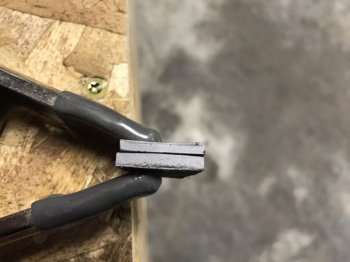As I said, I have always thought that very hard, and extensive, use in the task the knife was intended for is about the best overall test. I have seen knives chopping cinder blocks or getting driven through car doors and all I could do is laugh, this nonsense doesn’t tell anybody about knife performance, all it does is dumb down knifemaking to sell blades to the uninformed. For larger choppers, one of my favorites was asking a friend if they needed a fence row cleaned up, several hours of non-stop swinging and chopping would tell me about everything from the edge to the handle design.
Seasoned barn beam was also one of my favorites for chopping knives. For quick edge checks, I do have my version of the brass rod, it is not about flexing, it is about impact. After the blade is sharpened, I will whack the edge with a half inch brass rod, hard enough to get around 1/8” penetration. If I am particularly worried about the impact strength, I will repeat that test at a 45 degree angle to the edge for lateral stress. This, and chopping white tail antler are my extreme edge tests.
For fine cutters, I have done things like drop blades off at butchering, or deer processing, facilities and told them to give me feed back after non-stop use. Rope cutting is another old favorite that I am not a fan of, neither hanging, a la ABS, or slicing on the bench. Testing very early on showed me that it was very inconsistent and easily skewed by the cutter. Different grades of cardboard is much better. Corrugated is good if you have a lot of the same stuff, as it varies greatly from piece to piece. Hard, solid shipper tube type cardboard is an edge eater and gives good, consistent testing of the same.
With Kitchen knives- use them! There is no substitute. Get on a good cutting block and make a big bowl of pico del gallo and meat fajitas. It sounds funny but there are so many knife techniques in that meal that it is one of my favorite tests (well, cleaning up the testing materials is my favorite part). During a lot of the real use testing that I do, I will put the edge under the microscope, it needn’t be anything fancy 100X will do, and examine how it is changing. I don’t think about sharp versus dull under the scope as much as observe those changes.
What is much more important than the test is what you learn from it. Take note of deformation- is it plastic or brittle in nature? Do you need to change your blade shape or handle design? Record the edge geometries that work- what is the included angle? How thick is about .100” back, .200” and so on? This way you can isolate problems and recreate the ones that work.
On the material testing to troubleshoot heat treatment I will give you some alternatives to what I do, since it would be ridiculous for most people to do Rockwell overall with Knoop microhardness for selective areas of the cross section, Charpy impact, and metallography work. If one doesn’t have a Rockwell tester, I would really encourage them to think about having one someday, if they plan on making a career of knifemaking. But if they don’t, files are about your best option, you just need to be aware that files do not read the exact same properties as a penetrative hardness test. In that case I would use the file along with other efforts, like breaking the occasional sample and checking grain size. What most people need to be aware of is the difference between lab type testing, that gives accurate data by isolating variables and producing reliable numbers, and what most people consider testing. Just pushing an sharp edge into material and judging the ease with your hands is not the same type of testing. It is good enough for you to get a feel of things, but it does not account for uncountable variables, and it produces no numbers or quantifiable data to compare. The brass rod flex is a very good example, most people think this is telling them about the heat treatment in avoiding too soft or too brittle. It could give you some idea of that, but only after the yield point is exceeded, so it needs to be a destructive test to work. Before that point, all it is really reading is the thickness of the grind. Grind it thin and it will flex like crazy, regardless of the heat treatment. And, without measuring the exact angle and amount of load, it is not giving us any objective numbers to work with.

